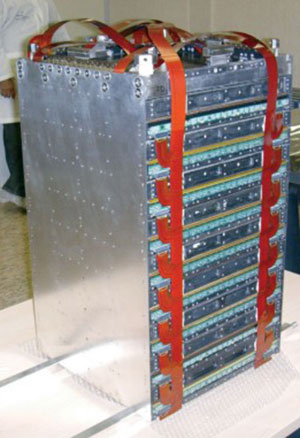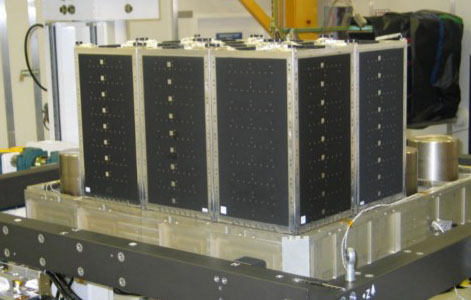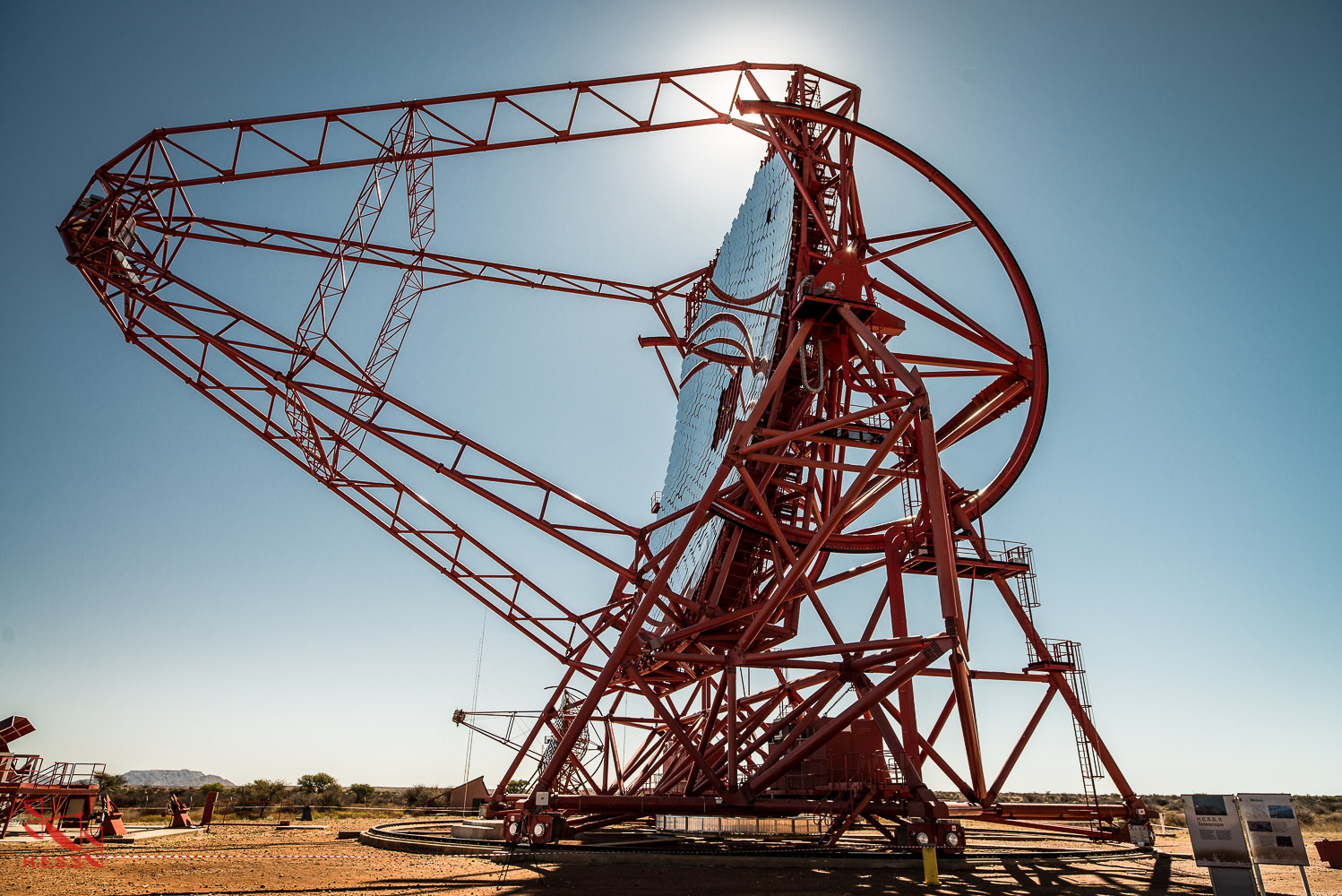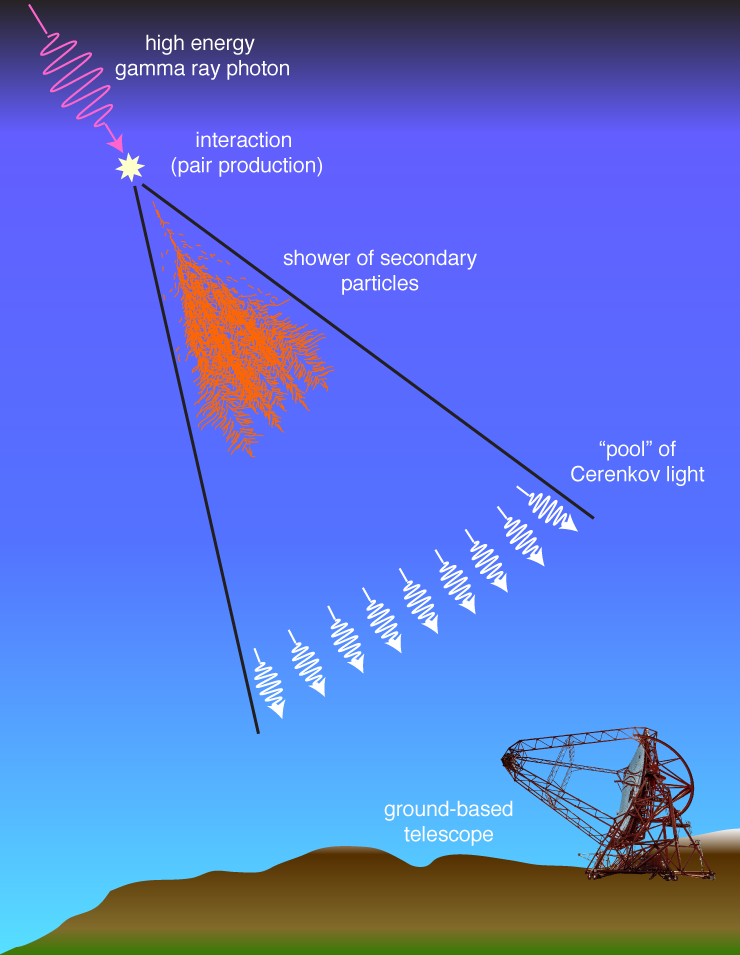Gamma-ray Detectors - More Information


Photos of detector towers for the Large Area Telescope on Fermi. On the left is a single tower, which is composed of a stack of interleaved planes of silicon strips and tungsten converters. On the right is a photo showing six towers installed on the detector housing. The LAT has 16 of these towers in a 4x4 array. (Credit: NASA/Fermi)
Gamma-rays pass through most materials, so they cannot be reflected by a typical mirror like we use for optical astronomy, or by using a special configuration of mirrors like we use for X-ray astronomy. Instead, the tools of high-energy physics are used to detect and characterize gamma-ray photons and allow scientists to observe the cosmos up to energies of 1 TeV (1,000,000,000,000 eV, compared to an optical photon which has an energy of a few eV) and beyond.
Gamma-ray detectors can be placed in two broad classes. The first class includes what would typically be called spectrometers or photometers in optical astronomy. These instruments are "light buckets" that focus on a region of the sky and collect as many photons as possible. These types of detectors generally use scintillators or solid-state detectors to transform the gamma ray into optical or electronic signals.
The second class includes detectors that perform the difficult task of gamma-ray imaging. Detectors of this type either rely on the nature of the gamma-ray interaction process such as pair production or Compton scattering to calculate the arrival direction of the incoming photon, or use a device such as a coded-mask to allow an image to be reconstructed.
The operation of scintillation and solid state detectors for gamma-ray astronomy is the same as it is for X-ray astronomy. We've described the basics of these types of detectors on the X-ray Detector page. Below we describe three types of detectors used uniquely for gamma-ray astronomy: Compton scattering detectors, pair telescopes, and air Cerenkov detectors.
Compton Scattering Detectors

Illustration of a Compton scatter interaction. (Credit: NASA's Imagine the Universe)
TIn this gamma-ray energy range, astronomers can study nuclear emission lines, pulsars, active galaxies, solar flares, and gamma-ray bursts. This is also the energy range where Compton scattering is the dominant physical interaction between light and matter. Compton scattering occurs when a photon hits an electron and some of the photon energy is transferred to the charged particle. The Compton scatter telescope design uses this interaction as the basis of its detection scheme.
Compton scatter telescopes are typically two-level instruments. In the top level, the cosmic gamma-ray Compton scatters off an electron in a scintillator. The scattered photon then travels down into a second level of scintillator material that completely absorbs the scattered photon. Phototubes viewing the two levels can approximately determine the interaction points at the two layers and the amount of energy deposited in each layer.

Illustration of a the basic operation of a Compton scattering detector. (Credit: NASA's Imagine the Universe)
Pair Telescopes
The pair telescope is a technology that was borrowed directly from the world of high-energy physics. At energies above about 30 MeV, pair production is the dominant photon interaction in most materials. A pair telescope uses this process to detect the arrival of the cosmic photon through the electron/positron pair created in the detector.

Illustration of the basic interaction in a pair-production telescope. (Credit: NASA's Imagine the Universe)
The standard instrument design is to have a layered telescope, with layers that convert gamma rays into electron/positron pairs interleaved with layers that track those pairs. The converter is typically a heavy metal, such as lead. The tracking material detects the pair. Once the electron/positron pair has been created they travel through the the chamber. The trail of the pair provides a three-dimensional picture of the electron/positron paths.
One type of tracking material is a spark chamber, which is a gas-filled region criss-crossed with wires. Another type of tracking material is silicon strip detectors, which consists of two planes of silicon. In one plane the strips are oriented in the "x"-direction, while the other plane has strips in the "y"-direction. The position of a particle passing through these two silicon planes can be determined more precisely than in a spark chamber.
By reconstructing the tracks of the charged pair as it passes through the vertical series of trackers, the gamma-ray direction, and therefore its origin on the sky, are calculated. In addition, through the analysis of the scattering of the pair or through the absorption of the pair by a scintillator detector or a calorimeter after they exit the spark chamber, the total energy of the initial gamma-ray is determined.
This animation shows how the Large Area Telescope on the Fermi Gamma-ray Telescope works. A gamma ray (purple) interacts with the detector, creating an electron-positron pair which cascade down the tower. Using the paths that the electron and positron take through the telescope, the direction of the original gamma-ray can be determined (shown in purple). (Credit: NASA's Goddard Space Flight Center Conceptual Image Lab)
Air Cerenkov Detectors

Photo of one of the HESS telescopes. The HESS array detects Cerenkov light from high energy gamma rays entering the Earth's atmosphere. (Credit: HESS Collaboration)
While a typical gamma-ray detector must be flown with a balloon or on a satellite above the Earth's atmosphere to avoid absorption of the gamma-ray photon, the air Cerenkov telescope makes Earth's atmosphere part of the detector itself. When gamma rays encounter the atmosphere, they create an "air shower." This process involves the original photon undergoing a pair production interaction high up in the atmosphere, creating an electron and positron. These particles then interact, through bremsstrahlung and Compton scattering, and give up some of their energy to create energetic photons. These in turn create more electrons, resulting in a cascade of electrons and photons that travel down through the atmosphere until the particles run out of energy.
These are extremely energetic particles, which means that they are traveling very close to the speed of light. In fact, these particles are traveling faster than the speed of light "in the medium of the atmosphere." Remember that nothing can travel faster than the speed of light in a vacuum, but that the speed of light is reduced when traveling through materials (like glass, water and air). The resulting polarization of local atoms as the charged particles travel through the atmosphere results in the emission of a faint, bluish light known as "Cerenkov radiation", named for Pavel Cerenkov, the Russian physicist who made comprehensive studies of this phenomenon.

Illustration of the process of detecting a gamma ray using Earth's atmosphere. (Credit: Diagram by NASA's Imagine the Universe; telescope image from the HESS Collaboration)
Depending on the energy of the initial cosmic gamma ray, there may be thousands of electrons/positrons in the resulting cascade that are capable of emitting Cerenkov radiation. As a result, a large "pool" of Cerenkov light accompanies the particles in the air shower. Air Cerenkov detectors, as the name implies, rely on the detection of this pool of light to detect the arrival of a cosmic gamma ray.
Air Cerenkov detectors begin with one or many large optical reflectors, and are usually placed at mountain sites where standard optical observatories might be located. The mirrors used can be of lesser quality than those used in optical telescopes, since they are reflecting the light of this large local pool rather than directly imaging an astronomical source. The Cerenkov light reflected from this mirror is then detected by one or many photomultipliers that convert the optical signal into an electronic signal to record the gamma-ray event. The light in this pool is very faint and can only be detected cleanly on dark, moonless nights. Even so, it helps that the total pool passes through the detector in only a few nanoseconds. This allows further separation of the faint signal from the ambient light from the rest of the night sky.
In this animation, gamma rays strike the atmosphere above the Canary Islands and cause a cascade of particles that produce a blue glow called Cherenkov radiation. (Credit: NASA's Goddard Space Flight Center Conceptual Image Lab)
Once the light has been detected in a phototube, fast electronics are used to record the signal. Many modern detectors use an array of 100 or more small phototubes in the focal plane rather than a single phototube. In this way, a crude image of the Cerenkov light pool is recorded. This is very important because these detectors can detect a large cosmic ray background in addition to detecting cosmic gamma rays. Cosmic ray protons and nuclei interact in the atmosphere in much the same way, creating their own Cerenkov light pools. The showers induced by cosmic rays come uniformly from all parts of the sky and mask the desired gamma ray signal. Less than 1% of the events detected are due to photons. The rest are cosmic rays.
Text updated: September 2018


